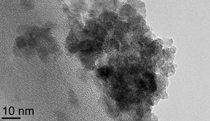Synthesis of Chromium-Nickel Nanoparticles Prepared by a Microemulsion Method and Mechanical Milling
Keywords:
Mechanical alloying, magnetic nanoparticles, magnetic hyperthermia, Curie point.Abstract
A chemical and a physical method have been applied for the preparation of chromium-nickel alloy nanoparticles. These particles were designed to be used for controlled magnetic hyperthermia applications. Microemulsions with Ni2+ and Cr3+ and/or NaBH4 as precursors were prepared using the isooctane/CTAB, n-butanol/H2O system. The samples of CrxNi1-x nanoparticles with the desired composition were obtained after the reduction of their salts with NaBH4 and afterwards heat treated in a TGA in a N2 atmosphere at various temperatures. The CrxNi1-x materials were also prepared by mechanical milling. Utilizing a ball-to-powder mass ratio of 20 : 1 and selecting the proper alloy compositions we were able to obtain nanocrystalline CrxNi1-x particles. Thermal demagnetization in the vicinity of the Curie temperature of the nanoparticles was studied using a modified TGA-SDTA method. The alloy’s phase composition, size and morphology were determined with XRD measurements and TEM analyses.

Downloads
Published
Issue
Section
License
Except where otherwise noted, articles in this journal are published under the Creative Commons Attribution 4.0 International License
